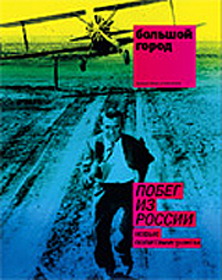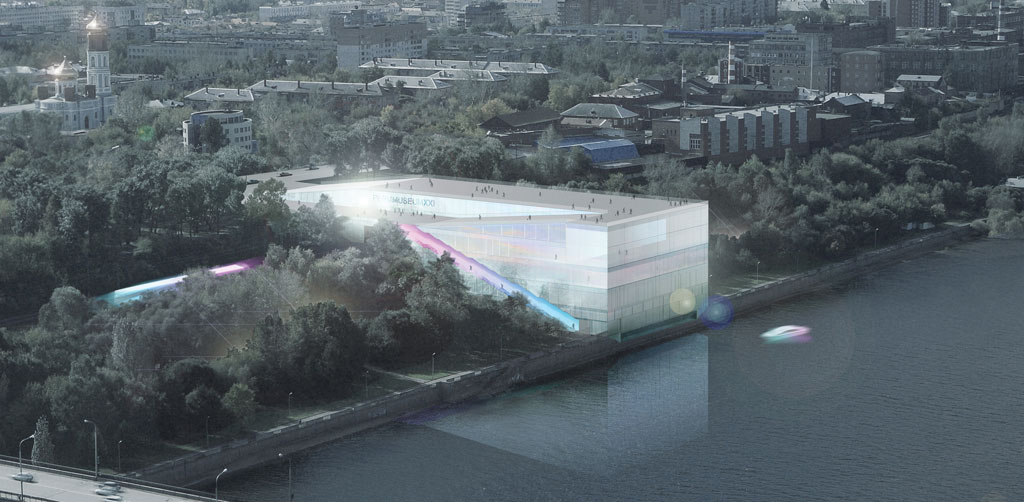
БОЛЬШОЙ ГОРОД.
Freemason.
What does your project look like?
It is a parallelepiped cut into the sloping bank [of the river] with a flat roof designed as a vast urban plaza. The structure connects the city above with the embankment. A huge glass and concrete thing.

What about the Trans-Siberian line going through the museum?
Well, it’s a kind of big story. Think it a part of the Transsib, a subsidiary branch line now used to carry coal.
There will be a railway station, won’t there?
Perm is a big city, a million-strong city. This year, the expected happened: now one half of the humankind – 50 % – lives in cities. (In about 15 years, I think, the three-fourth of the world will live in cities.) I believe that transport is one of the main things in architecture. There will be a station inside the building. I think it’s not a bad thing having a [railway] ticket bought to be able to enter the museum.

The city of Perm has set up an ambitious task for the museum to attract not only the city’s inhabitants but most importantly visitors from Moscow, St Petersburg, Samara and other cities.
This is a question of communication.
But there must be other reasons to go there. What will be the content of your museum?
If the museum continues to stay in the state it does now, you won’t want to go there. It’s like a mini-Tretyakov Gallery. They have the Italians, they have the 19th century, Russian avant-garde.
What do you think of this idea in general?As far as I know, a senator or governor of Perm went to Bilbao and saw how a sad enough industrial city in north Spain had been turned in 15 years into a tourist Mecca. They built the famous Guggenheim Museum. They built a metro to a Foster’s design. Many contemporary buildings, restaurants and hotels had sprung in the city… Presently he started daydreaming of the same things happened to Perm. To what extent are these plans utopian?
[Such changes] definitely can not be made with a single object. The question is if the Perm authorities are ready to develop all components.
What did you like in Perm?
The city is absolutely free, not constrained. When you are inside [the museum] you are aware of the vast space that surrounds you. That’s why our project is entitled ‘The Horizon’: the platform revealing and showing an idea of perspective. The original idea was not to build a building but to create a thing that is a kind of extension of the city.

All major architecture competitions with Western participants were won by them. They say it has caused anxiety to our president. He is said to have asked if the foreigners were really better or the reason was elsewhere. And now you for the first time wiped the eyes of the foreigners at such a high international level. Do you feel proud of that?
I didn’t plan to win. At the very beginning of the competition I examined the board of juries and awarded myself with an honorable prize for creative approach – I just put one more tick in front of my name.
Do you arge more for your work since you have won?
Not yet but I’m going to. I’m waiting for interesting commissions.
What have you managed to build by 31.
Not much. Several little houses, designed two settlements, one of which is built. Interiors of the Grand Cru wine stores. My first project was an office for BBDO. It was a rather big company office of 2.000 sq. m. We conducted a psycho-physiological experiment on employees there. We designed the space so that it was aggressive, uncomfortable: dark-gray paint, low gray ceilings, and special light. We came to the conclusion that the creative person doesn’t mind the interior. People who think interior is important are not creative at all.
You were tyrants!
Yes, we were. But it was useful. After this, half of the employees left but the most creative stayed. This was evidence that our design worked, that space could have an influence.
You won’t experiment with your museum project, will you?
There are experiments in the project, of course. But these experiments are aimed at better presentation and better use of the facilities. The space is designed in a ‘menu’ fashion, as a website interface. Circulation inside the museum is organized so that visitors intuitively find what they want. For instance, the largest entrance leads to the main collection; a smaller one to the temporary exhibition. The exit is lit so that the light is leading a visitor. All surfaces of the building are used for navigation with texts and so on. The program is very complicated. [I had to solve the problems of] transport, storage, display etc. I spent a great deal of time and nearly died.

Will you cope with construction?
No problem. I’m prepared to finish it within three years. We start designing in September. In September 2012, I invite you to cut the ribbon. After that, everything will depend on a person who will support it – a politician or somebody else.
There is already a talk about a hundred buck start and a 50 cent end. People understand what a mess thy got into and start sobering up.
Sobering up from what?
From crazy and extremely ambitious plans.
Oh, no! It’s like building a shopping center in a Moscow suburb. The building is 20,000 sq. m, it’s ridiculous. The space for Oleg Kulik’s exhibition in the Central House of Artist that I did was 10,000 sq. m.
So it was you? Accept my most sincere gratitude. Let’s get back to the competition. There were two Grand Prixes presented, is that right?
Yes, another winner was Valerio Olgiati.
Did you like his project? Is he Italian?
No, he is from Switzerland. His project was good. One of the few projects that was thoughtful.

What about Zaha Hadid?
She made an urban sculpture and a very expensive one. I think museum should not be super-expensive for society; it’s a social object after all.
Where did you get your last name, by the way? A common Russian guy…
Yes, Russian guy Bernaskoni. I’m from St Petersburg. The Bernaskonis came to St Petersburg to work. There are two cities – Bern and Ascona – in Switzerland. I was there: fields, yachts, hotels – paradise. In the 16th century [the Bernaskonis] moved to Italy and from there came to Russia as hired architects to design Petergof in the 18th century. Bernaskoni took part in the construction of the St Isaak’s Cathedral. Finally, we came to Moscow.
Do you believe in the construction of the museum in Perm?
I would refer this to the category of dreams.